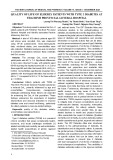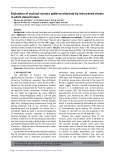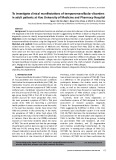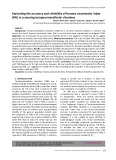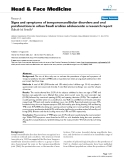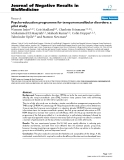
HUE JOURNAL OF MEDICINE AND PHARMACY ISSN 3030-4318; eISSN: 3030-4326 45
Hue Journal of Medicine and Pharmacy, Volume 14, No.4/2024
Evaluating the accuracy and reliability of fonseca anamnestic index
(FAI) in screening temporomandibular disorders
Nguyen Minh Quan1, Nguyen Cong Sinh1, Nguyen Gia Kieu Ngan1*
(1) Faculty of Odonto-Stomatology, Hue University of Medicine and Pharmacy, Hue University
Abstract
Background: Temporomandibular disorders (TMD) are a common medical condition in Vietnam and
around the world. Fonseca Anamnestic Index (FAI) is a quick and simple questionnaire to diagnose TMD.
Objectives: (1) To evaluate the accuracy and reliability of FAI in the diagnosis of TMD and (2) to suggest
adjustments to enhance the clinical value of FAI. Material and method: This study included 198 students (69
males, 129 females) from the Faculty of Odonto-Stomatology, Hue University of Medicine and Pharmacy. This
study is conducted from 06/2022 to 12/2022. Participants initially filled out FAI questionnaire, then followed
by questionnaire and clinical examination using Diagnostic Criteria for Temporomandibular Disorder (DC/
TMD) as a gold standard. Results: According to DC/TMD, the prevalence of TMD among students was 34.8%.
FAI had high sensitivity (97.1%) but low specificity (40.46%) (cutoff point = 17.5), Cronbach Alpha value was
0.684. The suggested cutoff point was calculated at 22.5. Only Question 8 from FAI questionnaire showed
insignificant difference between TMD and non-TMD group. By extracting the 8th question with the cutoff
point at 22.5, the sensitivity and specificity of the modified questionnaire was 82.1% and 64.9% respectively
and the Cronbach Alpha value mildly increased to 0.692. Conclusion: The FAI is suited for screening patients
with TMD because of its high sensitivity. However, FAI low specificity makes it not optimal for efficiently
diagnosing TMD. It is suggested to modify the FAI by eliminating the 8th question in the questionnaire and
have a higher cutoff point (23).
Keywords: accuracy, reliability, Fonseca Anamnestic Index, Temporomandibular disorders, adjustments.
1. INTRODUCTION
Temporomandibular disorders (TMD) are a
medical condition that affect the masticatory muscle,
temporomandibular joints (TMJs), and other related
structures [1]. The three main symptoms of TMD
includes orofacial pain, movement reduction of the
jawbone (mandibular movement dysfunction), and
abnormal temporomandibular joint sound [2]. The
most common group age of TMD is between 20 - 40
years old. The incidence rate of TMD in women is
higher than men [3, 4]. A number of epidemiological
studies have indicated that TMD is the most prevalent
non-dental cause of orofacial pain. Approximately
40-60% of the general population exhibit signs
and symptoms of TMD; 41% of this group report
experiencing at least one symptom related to TMD,
while 56% show at least one clinical sign [1]. The
results of various studies, both in the world and in
Vietnam show that TMD is a common issue. A study
by Bertoli F. (2018) on Brazilian adolescents found
that 34.9% had symptomatic TMD [5]. Wieckiewicz
M.’s research (2014) on university students in Poland
reported a TMD prevalence of 54% [6]. In Vietnam,
Hoang A. carried out a research in 2015 that
examined 201 Dental students at Hue University of
Medicine and Pharmacy, uncovering that 72.6% of
the students demonstrated the presence of at least
once indications or symptoms of TMD [7].
As TMD are a multifactorial disorders [4], a
comprehensive tool is required to assess TMD in
all perspectives. There are several instruments
currently used around the world, but the current
accepted golden standard for diagnosing TMD
is the Diagnostic Criteria of Temporomandibular
Disorder (DC/TMD). DC/TMD is a comprehensive
tool with 2 axes: Axis I is for clinical examination
and Axis II provides assessment for pain behavior,
psychological status and psychosocial functioning.
However, it is not suitable to apply DC/TMD in
epidemiological studies and clinical classification,
due to its prolonged procedure, requirement for
training and complex diagnosing process. Therefore,
to facilitate the need of a quick and simple
assessment tool, Fonseca Anamnestic Index (FAI)
was proposed to examine the prevalence of TMD in
clinical and community samples [8, 9].
Corresponding author: Nguyen Gia Kieu Ngan. Email: ngkngan@huemed-univ.edu.vn
Received: 30/11/2023; Accepted: 10/6/2024; Published: 25/6/2024
DOI: 10.34071/jmp.2024.4.6





